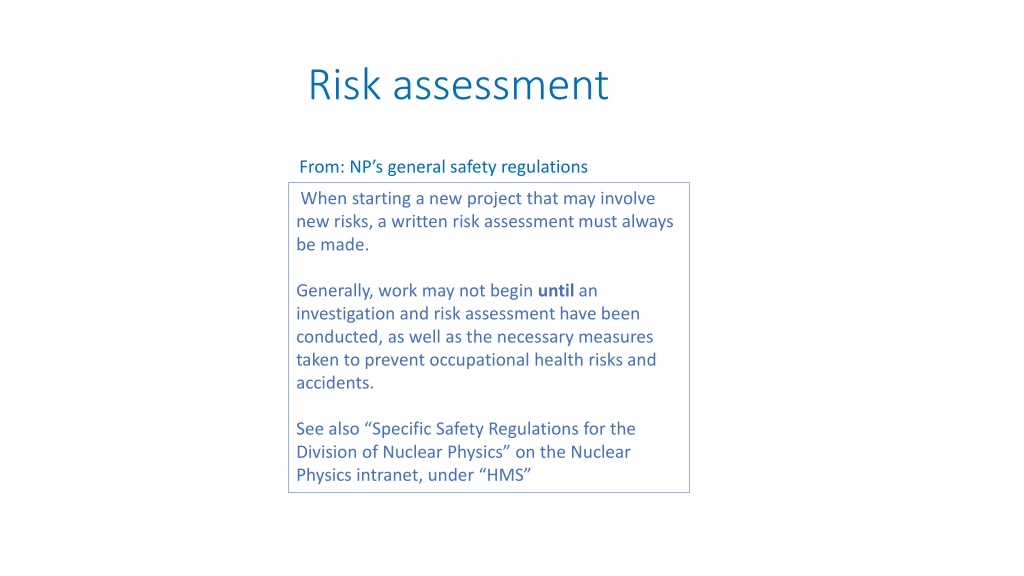Risk Assessment Guidelines and Procedures for NP Projects
Guidelines and procedures for conducting risk assessments in Nuclear Physics projects are outlined, emphasizing the importance of assessing and mitigating occupational hazards before work commencement. Detailed instructions on when, how, and by whom risk assessments should be carried out are provided, along with the roles of key personnel in the approval process. Specific requirements for new projects, laboratory activities, and handling of chemicals and ionizing radiation are highlighted to ensure a safe working environment. The significance of keeping records and accessible copies of approved risk assessments is underlined for ongoing safety compliance.
Download Presentation

Please find below an Image/Link to download the presentation.
The content on the website is provided AS IS for your information and personal use only. It may not be sold, licensed, or shared on other websites without obtaining consent from the author. Download presentation by click this link. If you encounter any issues during the download, it is possible that the publisher has removed the file from their server.
E N D
Presentation Transcript
Risk assessment From: NP s general safety regulations When starting a new project that may involve new risks, a written risk assessment must always be made. Generally, work may not begin until an investigation and risk assessment have been conducted, as well as the necessary measures taken to prevent occupational health risks and accidents. See also Specific Safety Regulations for the Division of Nuclear Physics on the Nuclear Physics intranet, under HMS
Risk assessment From: NP s special safety regulations Risk assessment should be carried out in all cases where there is a risk of occupational injury, but also in other cases, for example, the risk of theft and computer hacking. Risk assessment must be carried out for each doctoral project and for laboratory practicals in undergraduate teaching. The Head of Division is responsible for ensuring risk assessments are carried out, and he or she should be able to be present them to the Head of Department.
Risk assessment Risk assessments are to be carried out for all laboratory activities, as described below. Update to be implemented in NP s specific safety regulatoins 1. When starting a new project that may be associated with significant new risks, a written risk assessment of the project must always be made. This risk assessment is only valid for 1 year, and must then be updated. Material data sheets must not be older than 3 years when the risk assessment is made. 2. Risk assessment of laboratory operations should normally be made by the person who is to perform the work and in the system for management of chemicals KLARA. If there is a change in personnel, a new risk assessment should normally be made. Contact Mattias Olsson regarding the risk assessment of chemical hazards. Risk assessments are to be reviewed by Mattias Olsson and approved by the Head of Division before work commences. Contact Mikael Elfman regarding the risk assessment of ionizing radiation hazards. Risk assessments are to be reviewed by Mikael Elfman and approved by the Head of Division before work commences. 3. When the risk assessment is made by someone other than the person who is going to perform the work, the person making the risk assessment is responsible for ensuring that the person who will carry out the work has read and understood the risk assessment, signs a declaration to this effect, and agrees to comply with the measures set out in the risk assessment. 4. The original is to be kept by the Head of Division. 5. A copy is to be kept so that it is readily accessible in the area in which the work is being carried out.
Mangement of risk assessments at NP 1 2 3 4 5 If chemicals are involved, via Mattias Olsson for review and approval If ionizing radiation is involved, via Mikael Elfman for review and approval Group leader or other senior reviews. HMS- Head of div (Kristina) + Head of Div (Erik) Each coworker: Risk assessment of laboratory activity Group leader/ senior signs! Head of Div signs! Mattias signs! Sign! Mikael signs! Feedback, copy to coworker Accessible copy of approved risk assessment is kept where work is being carried out Original is kept at Head of Division At work performed outside of the Division premises (e.g. aerosol lab): Copy of risk assessment, approved according to the routines at the lab, is sent to NP Head of Division This prodecure applies from new risk assessments from 2021-05-07. Before any work involving significant risks starts, a riskassessment must be done and must be approved. May presently be done electronically due to Covid restrictions
Example risk assessment Examine working conditions and identify the sources of risk and risk factors. Assess the sources of the risk identified. State whether the risk is serious or not. Clarify who is responsible for the measures to be taken, when they should be implemented, and a follow-up date or occasion. Implement the measures. Make an action plan for what is not implement immediately. Follow the guidelines and measures to be taken from the Lund University and LTH. Check if the measures have had an effect. Risk description Impact description Impact assessment Negligible/Moderate/ Serious Probability Low/Medium/ High Proposed measures to reduce the risk Person responsible Other Exposure to ionizing radiation using low-activity radioactive sources at laboratory excercises Estimate dose rate before handling the source Risk of high exposure of ionizing radiation, leading to health effects Moderate/Serious Low (that exposure limits are exceeded) Use proper radiation shielding at all times Use dosimeter Use forecepts at handling the source Maximize distance between source and person Minimize time of exposure Wash hands when leaving lab No eating or drinking int the lab Relevant if chemical risks involved Relevant if ionizing radiation risks involved Date Signature Name Mattias Olsson Mikael Elfman Erik Swietlicki Role Employee Chemistry function Ionizing radiation function Group leader Head of Division























